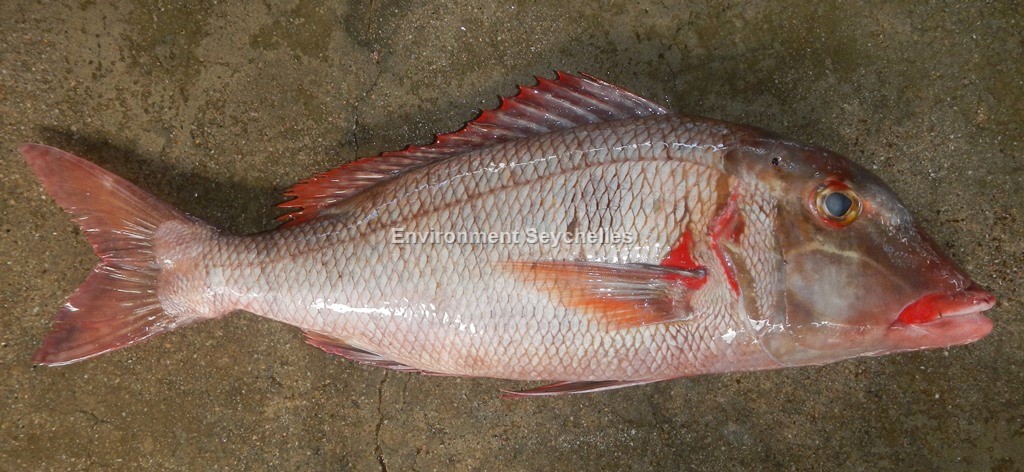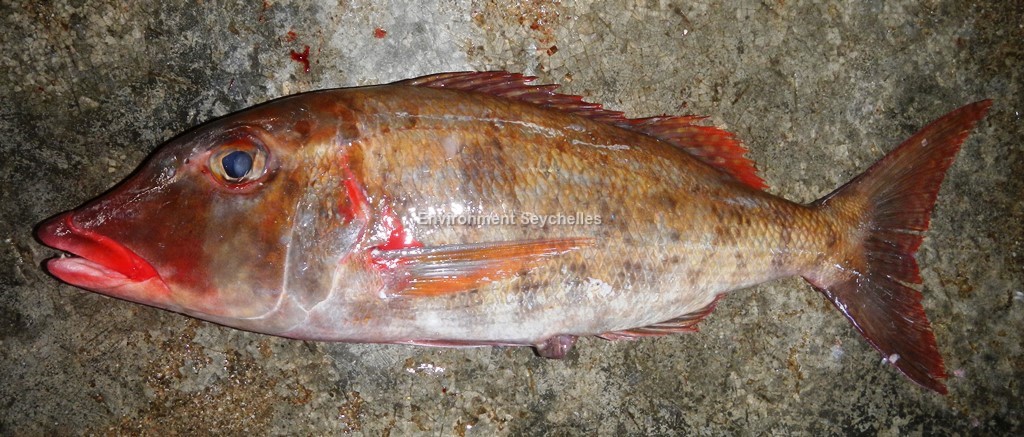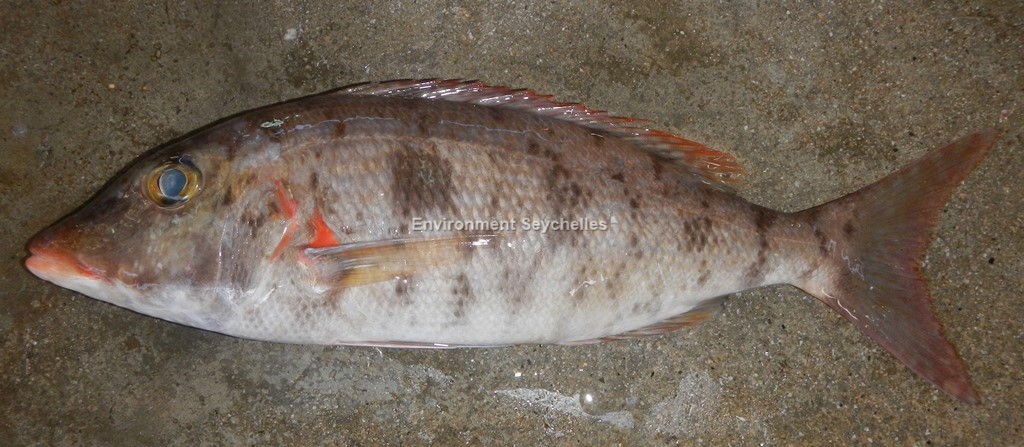Description:
Dorsal spines: 10; Dorsal rays: 9; Anal spines: 3; Anal rays: 8.
Body fairly elongate. Dorsal profile concave with hump in front of eye. Posterior nostril a longitudinal opening, closer to orbit than to anterior nostril. Lateral teeth in
jaws conical. Cheek without scales.
Body and head brownish grey, lighter ventrally. In life may have irregular dark pattern and notably a rectangular dark patch below the lateral line above the distal portion
of the pectoral fin. This patterning may be more pronounced in younger specimens. Adults have distinctive bright red lips. The base of the pectoral fin, a patch above the
base of the pectoral fin and the edge of the operculum are also bright red. These coloured areas are more subdued and less extensive in smaller specimens. Fins are orangish,
dusky or mottled. The dorsal fin has a relatively broad reddish margin.
Size:
Maturity: Lm unknown. Range unknown. Max Length: 76 cm TL. Commonly 50 cm TL.
Habitat and Ecology:
Inhabits reefs and adjacent sand, rubble and weed areas (depth 5-220 m). Feeds on crustaceans and small fish. Typically solitary.
Fishery Status:
This species is not protected or subject to fishery regulations. It is caught in the hand line fishery. It is a regular but not a common component of the catch; it can on
occasion be numerous in a catch.
Notes:
References:
Carpenter, K.E. & Allen, G.R. (1989). FAO Species Catalogue. Vol. 9 Emperor Fishes and Large-eye Breams of the World (Family Lethrinidae). An annotated and Illustrated
Catalogue of Lethrinid Species Known to Date. UNFAO Rome. ISBN 92-5-102889-3
Collen, B. et al. (2010). Lethrinus conchyliatus. The IUCN Red List 2010: http://dx.doi.org/10.2305/IUCN.UK.2010-4.RLTS.T155118A4715433.en. (14/05/19).
Froese, R. & D. Pauly. (Eds.) (2019). FishBase. https://www.fishbase.se/summary/1868 (14/05/19).
Nevill, J. (2013). A Species Identification Guide for Commonly Caught Fish in the Seychelles Near-Shore Artisanal Fishery. GOS/UNDP/GEF.
Citation:
Nevill, J.E.G. (2019). Lethrinus conchyliatus, Redaxil emperor. Seychelles Seatizens. www.seatizens.sc. https://seatizens.sc/species/lethrinus-conchyliatus-smith-1959/ (edited 15/07/22).




pin up giris: pin up yukle – pin up apk yukle
buying prescription drugs in mexico: Mexico pharmacy that ship to usa – medicine in mexico pharmacies
https://northern-doctors.org/# best online pharmacies in mexico
mexico drug stores pharmacies [url=http://northern-doctors.org/#]Mexico pharmacy that ship to usa[/url] mexican online pharmacies prescription drugs
https://northern-doctors.org/# buying prescription drugs in mexico
mexican pharmaceuticals online: northern doctors – mexico drug stores pharmacies
mexican pharmaceuticals online [url=https://northern-doctors.org/#]northern doctors pharmacy[/url] best online pharmacies in mexico
reputable mexican pharmacies online: mexican northern doctors – mexican border pharmacies shipping to usa
https://northern-doctors.org/# mexico drug stores pharmacies
mexican pharmaceuticals online: Mexico pharmacy that ship to usa – mexican border pharmacies shipping to usa
medication from mexico pharmacy [url=https://northern-doctors.org/#]Mexico pharmacy that ship to usa[/url] buying prescription drugs in mexico
Your humor added a lot to this topic! For more information, click here: FIND OUT MORE. What do you think?
buying prescription drugs in mexico [url=https://northern-doctors.org/#]mexican pharmacy northern doctors[/url] mexican rx online
https://cmqpharma.online/# purple pharmacy mexico price list
п»їbest mexican online pharmacies
Online medicine order: india pharmacy – cheapest online pharmacy india
mexico pharmacies prescription drugs: mexico drug stores pharmacies – mexican online pharmacies prescription drugs
canadian online pharmacy [url=http://canadapharmast.com/#]canadian family pharmacy[/url] ed drugs online from canada
mexican drugstore online: buying prescription drugs in mexico online – buying prescription drugs in mexico online
Online medicine order: cheapest online pharmacy india – india pharmacy mail order
indian pharmacy online: india online pharmacy – best india pharmacy
п»їlegitimate online pharmacies india [url=https://indiapharmast.com/#]mail order pharmacy india[/url] reputable indian online pharmacy
canadian pharmacy 24: buying drugs from canada – onlinecanadianpharmacy
canadian pharmacy scam: onlinepharmaciescanada com – onlinecanadianpharmacy 24
Great site you have here.. It’s difficult to find high-quality writing like yours nowadays. I honestly appreciate people like you! Take care!!
http://paxloviddelivery.pro/# п»їpaxlovid
clomid no prescription [url=http://clomiddelivery.pro/#]can i get clomid without dr prescription[/url] where to buy clomid without a prescription
When I initially left a comment I seem to have clicked on the -Notify me when new comments are added- checkbox and from now on each time a comment is added I recieve four emails with the same comment. Is there an easy method you can remove me from that service? Thank you.
http://paxloviddelivery.pro/# buy paxlovid online
amoxicillin 200 mg tablet [url=https://amoxildelivery.pro/#]purchase amoxicillin 500 mg[/url] price for amoxicillin 875 mg
ciprofloxacin: ciprofloxacin 500mg buy online – buy generic ciprofloxacin
Good day! I could have sworn I’ve been to this site before but after going through a few of the articles I realized it’s new to me. Nonetheless, I’m definitely happy I came across it and I’ll be bookmarking it and checking back frequently.
https://amoxildelivery.pro/# amoxicillin where to get
amoxicillin 500 mg where to buy [url=http://amoxildelivery.pro/#]amoxicillin order online[/url] how to get amoxicillin
buy cipro cheap: ciprofloxacin order online – buy cipro cheap
http://ciprodelivery.pro/# buy cipro online
buy generic clomid pill [url=https://clomiddelivery.pro/#]cheap clomid now[/url] cost generic clomid for sale
http://ciprodelivery.pro/# ciprofloxacin mail online
paxlovid pill [url=https://paxloviddelivery.pro/#]Paxlovid buy online[/url] п»їpaxlovid
http://doxycyclinedelivery.pro/# doxycycline 100mg generic
doxycycline 100mg capsules uk [url=http://doxycyclinedelivery.pro/#]doxycycline india pharmacy[/url] doxycycline tablets where to buy
I could not resist commenting. Very well written!
http://ciprodelivery.pro/# purchase cipro
ciprofloxacin over the counter [url=http://ciprodelivery.pro/#]cipro 500mg best prices[/url] buy cipro online canada